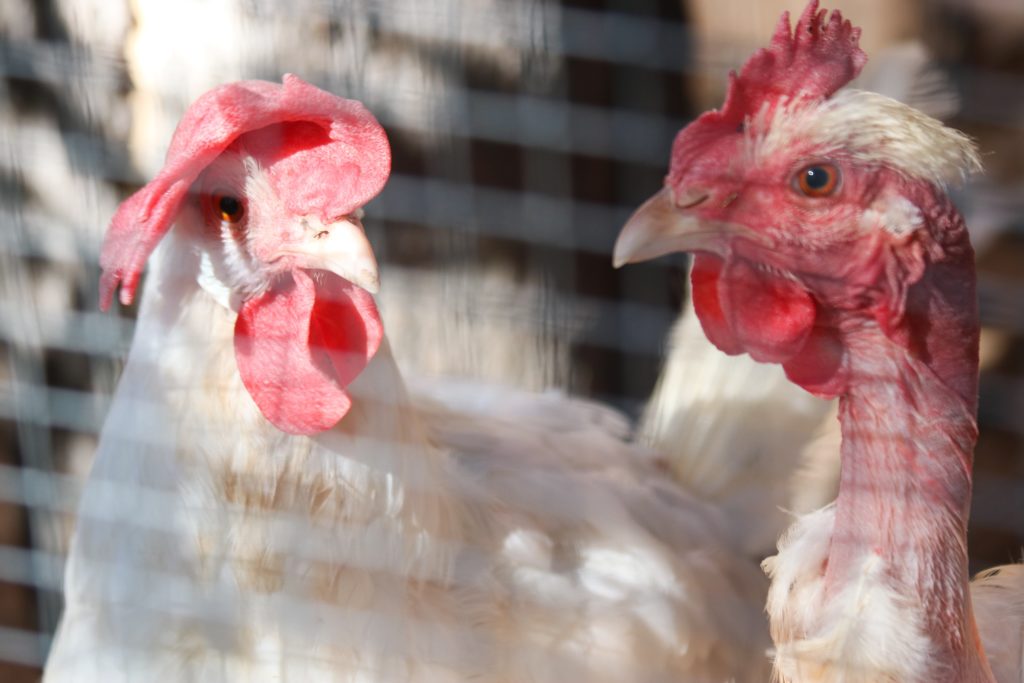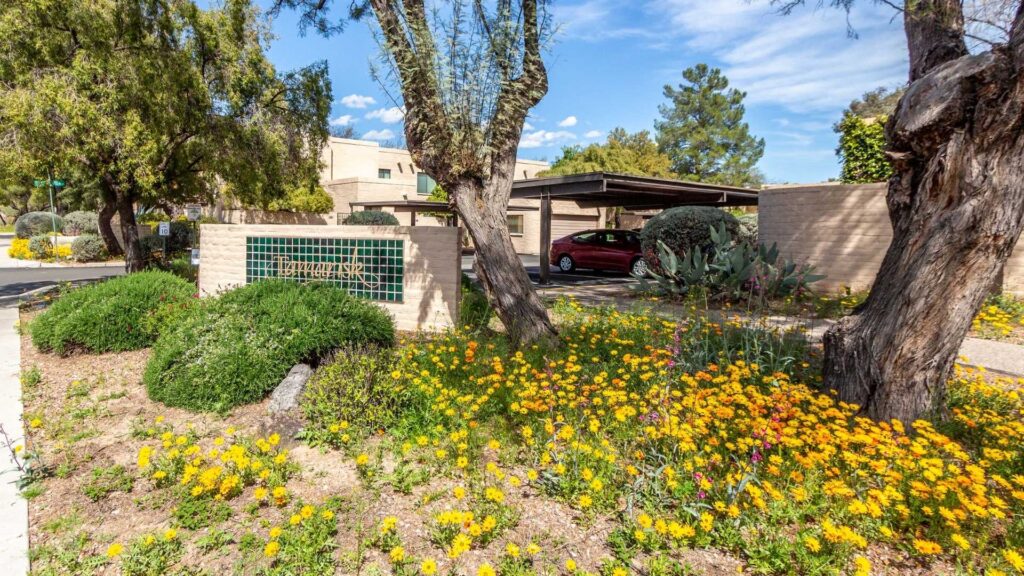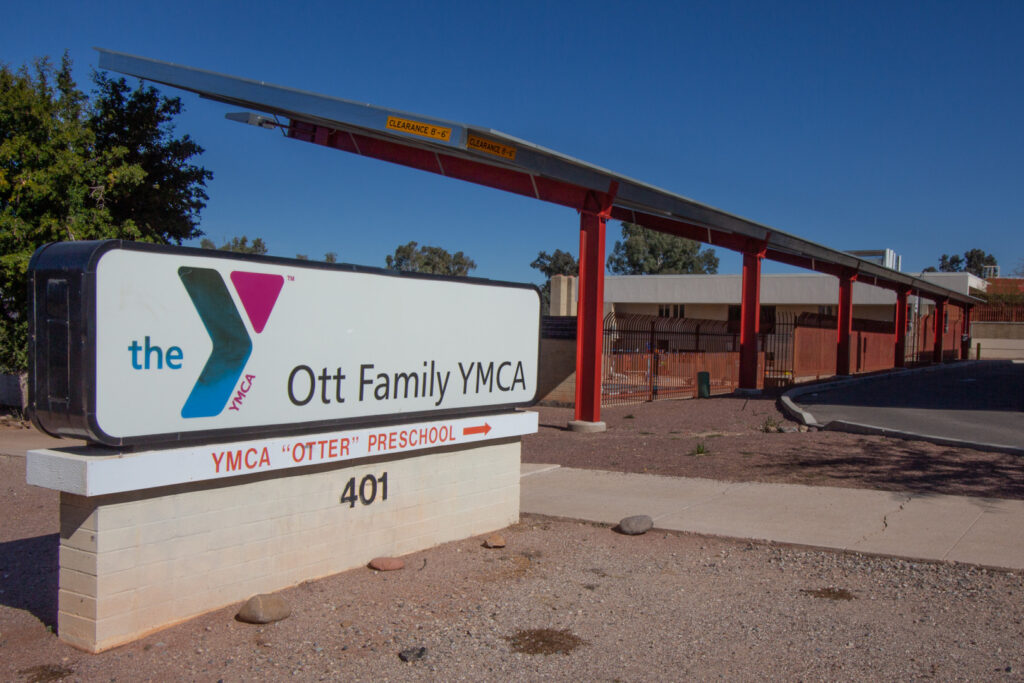Last Updated on July 20, 2020 by Kim Labriola
“Reprinted from the Pima County Master Gardener Sonoran Seasons Newsletter – Dec 2019”
Raising chickens in Tucson has become easier since the Tucson City Council, in a unanimous vote, approved an urban agriculture text amendment to the city’s unified development code in 2015. According to the Arizona Daily Star the amendment reduced barriers to raising backyard chickens and vegetable gardens and clarified rules for community gardens and farmers markets. No doubt the urban farming revival in the recent decades had something to do with this popular vote and, although numbers are hard to come by, it seems that more and more fellow Tucsonans raise chickens in their backyards.
Living in mid-town, I decided to give my local Ward office a call to see if they have had any issues since the code change my part of Tucson. According to the folks at the City’s Ward 6 office, they can count only a couple of complaints in the last few years related to folks having chickens. Those would be noise related to roosters crowing – a reminder that within the city limits roosters are a no-no. Be sure to check out the current codes for your area including any HOA restrictions.
Raising your own chickens has many advantages, like knowing where your food (eggs/poultry) comes from and being able to manage what goes into it.
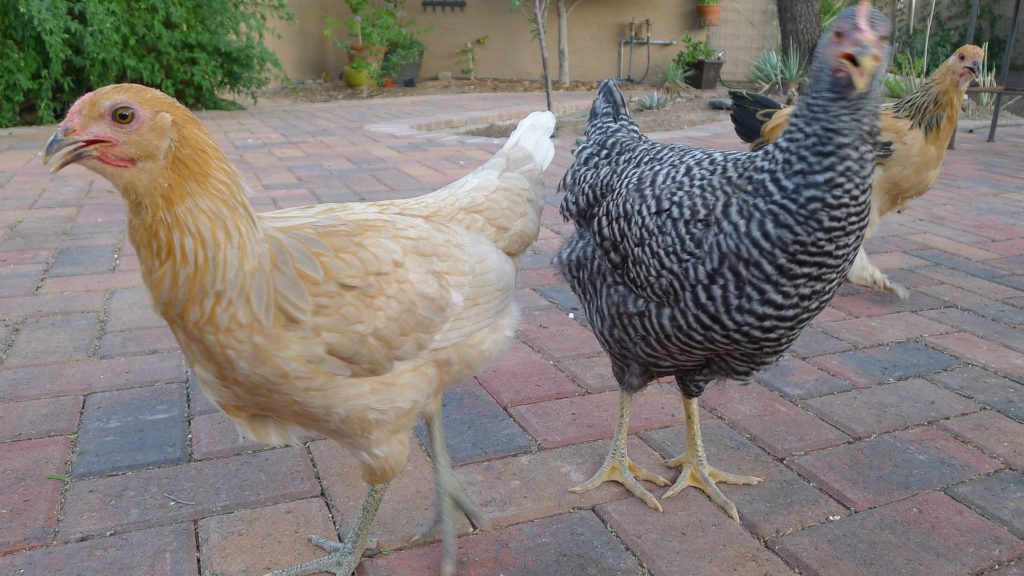
Do a little research first!
Ready to raise some chickens and have farm fresh eggs for breakfast? Before running out to pick up a few of those cute little fluffy chicks at your local feed store, you should do a little research.
My husband and I have had chickens since 2014. It’s just the two of us, so we don’t have many, just three and they provide all the eggs we can eat. Over the years we have made changes to our setup outside and figured out tricks to manage some of the unfortunate side effects of having chickens. Examples of these changes would be adding misters to help combat the Tucson summers (we have lost two due to heat exhaustion); hen-house reconfigurations to make cleaning easier; feeders/containers that deter mice and other rodents from eating chicken feed and taking up residence; selecting breeds that do better with consistent egg production and heat tolerance along with too many other things to mention for this article. Trust me, you will learn a lot as you go!
My 3 Backyard Chickens
I’ll introduce you to my three: Lucy is an Americauna/Easter Egger mix breed, is about five years old, lays light green colored eggs although less often than she used to due to her age; Blondie is a Leghorn breed, is about two years old and is an egg laying machine! Olive is a Naked Neck breed, is about two years old, lays beige colored eggs and has very thin shells. Because of Olive, we add a calcium supplement to one of our water supplies since she is not getting enough through oyster shells like the others.
Need a home with a larger backyard for your chicken coop? We can help you with that.
Things to consider: Space, Predators, Disease, Heat, Lifecycle
Space:
How much space is needed per bird? According to the guidelines set by the Urban Architecture code: “An enclosed henhouse with at least two (2) square feet per hen and nesting box for each three chickens. An enclosed pen or run at least four (4) square feet of pervious surface per hen kept on the property. Maximum height of the run shall be no taller than six (6) feet”. More square footage is better. Skimping on space requirements for a flock of chickens can cause stress, cannibalism, pecking, and sometimes even death.
One more thing to put into your coop equation is you. You will have to get in there often to clean and maintain food or water supplies. Give yourself some space to move since you will be there often hanging out with the ladies!
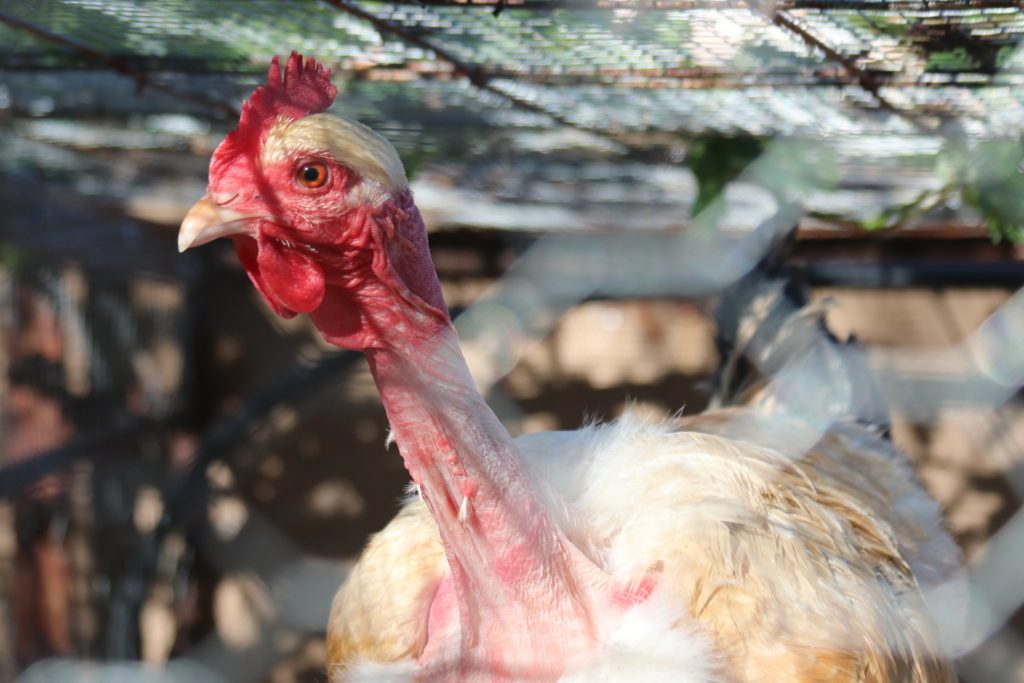
Predators:
Fortifying your coop to protect from predators will save your chickens (and you) a lot of pain and heartache. Alex Atkin over at the Tucson Village Farm says that the most common conversations she has with folks is over their experiences of a coyote or family dog getting into the coop. As you can imagine, most of these stories end badly.
Where to begin? Starting at the base then working your way up is a good idea. If you happen to be by a wash that attracts a lot of wildlife, you may want to have the coop sitting on a slab of concrete. Others like fellow MG Carol Schneiderman buries blocks wrapped in chicken wire or hardware cloth underground and continue that up the sides (think predators that bury). Hardware cloth is stronger than chicken wire and a semi-flexible, sturdy material in general.
Be sure to tighten up any large gaps in your coop, so you don’t leave space open for little paws to reach in and harm curious hens. I know of some that don’t see a need to cover the top of a coop but remember that coyotes or large cats have no problem jumping over walls. I had a neighbor tell me she watched as a group of four coyotes jumped our 6ft block wall one by one late at night. We strengthened our coop roof soon after that to make it a little stronger than just chicken wire to handle the weight of a coyote (just in case).
Disease:
Cleanliness is next to godliness! Food and water in the coop area tend to attract more than just chickens – birds, mice, flies, ants and larger predators etc. Some of these pests bring friends in the way of mites or ticks and even disease to your flock. Maintaining the coop and especially keeping the food and water areas clean will help the overall health of your flock. Water containers should be cleaned to make sure there is no algae build up. Most people like to use bottles or buckets fitted with nipples on the bottom to allow easy access of water to their birds. No waiting in line for a drink when you have 4 nipples attached to the bottom of a bucket!
A complete feed from your local feed store is the simplest way to feed a small flock of chickens and I’ll say you also may want to consider what type of food container you use. Local feed stores have many to choose from and there are various DIY options out there so you should be able to find one to fit your needs.
We use a treadle feeder where the weight of the chicken on a platform opens the feeder door to allow access to the food. Smaller birds or mice can’t get into the food supply that way.
Whatever food container you choose, think about what is coming over to eat that food after the ladies go to roost at night. If you go with an open access type of food container, it is recommended that you at least lift it off the ground or even take away the free all-night buffet each night to help combat this common problem.
A tip from Thom Plasse from Tucson Village Farm relating to coop cleanliness – “The best way to prevent disease is to avoid cross-contamination with other flock or other birds. Ideally you would build the coop structure so that birds can’t fly in and transmit diseases.
When you enter the coop it’s important to make sure that you haven’t recently been around other chickens or set up some sort of sanitary bath for your shoes. Or just have a pair that you use exclusively for entering the coop”. In addition to your flock, neighbors will appreciate your coop attention which will keep odors to a minimum and the bedding clean. A standard rule of thumb is weekly removing visible manure and completely replacing the coop bedding every 60 days.
Heat:
Battling heat is a biggie here in the southwest. Like dogs, hens do not sweat and heat loss is achieved through respiration. It’s imperative that you allow lots of access to water – drinking, misting and wading. From my own experience I thought I had done enough to keep my ladies cool early on, but we still lost one due to heat exhaustion (I felt terrible). After that, we made some changes mentioned earlier – added misters in the coop to spray a mist multiple times a day and make sure I add ice to their little water pool (kids swimming pool) multiple times a day during high temperatures.
Needless to mention for those in Tucson, shade is a must! As you know, standing in the shade can feel 10-15 degrees cooler. Make sure to have some shade cloth, or leave space under the hen house for shade, add umbrellas – anything really. Just like you, birds need to stay hydrated to help beat the heat – frozen treats, melons, safflower seeds in ice cubes are all great ways to help them keep cool and take in fluids. When thinking heat, breed can also be a consideration. Last time I made the move to introduce some new chicks to the flock, I researched smaller and more heat tolerant birds.
How can you tell if your hens are hot?
According to the UArizona Cooperative: “A “hot” hen may be seen panting lightly, but otherwise will be running around acting normal. A hen under light or moderate heat stress may pant more heavily. She will also hold her wings away from her body and crouch slightly to aid in heat dissipation through the unfeathered areas under her wings. These hens are not in immediate danger but should be moved to a cooler area with shade and water to prevent heat exhaustion.
A hen in danger of heat exhaustion will be panting heavily and holding her wings away from her body. She may have a pale waddle and comb, she may be lethargic, limp, or unconscious. A chicken exhibiting these symptoms is in extreme danger of dying from heat stress and needs to be cooled quickly. Submerge her body (not her head) in a bucket of cool (not icy) water and place her somewhere cool such as in the house until she is completely recovered”.
Lifecycle:
How old does my little chick need to be before she lays her first egg? How long do chickens lay eggs? How old will my chicken get? Let’s start at the beginning!
Your young hen or “pullet” can start laying eggs as early as 18 weeks (depending on breed). A healthy hen will lay reliably for the first 2 years and then more sporadically until they are 5 to 7 years old. Lifespan is an average of 8-10 years, but there are the occasional 20-year oldies out there!
I know folks that cull/eat their chickens after they no longer produce regularly, but I’m not ready to move in that direction. I figure they can enjoy their semi-retirement and we enjoy the surprise light green occasional egg!
Urban Farming Is Here To Stay
Fads come and go – remember the pet rock? Let’s hope the urban farming movement keeps going with more folks raising their own food for the future generations to continue. Having chickens sounds like a lot of work, but honestly, they are some of the easiest animals at our home once we had the set up and routine down.
And don’t forget the entertainment value of sitting on your patio with a martini in hand, watching the ladies in their evening ritual of negotiating who will sit on the highest perch for the night.
This article was written by Stephanie van Latum. Stephanie is our colleague at Long Realty, as well as a fellow midtown Tucson resident. Along with raising chickens, she also enjoys photography, painting, cooking, gardening, hiking, camping, music, and traveling.
Interested in buying or selling a home in Tucson? Contact us to go over your needs. 520-975-8956 or Hello@RealTucson.com
Related Articles
Hill Farm Neighborhood – Lake Front Property in Tucson
About Hill Farm Hill Farm is a beautiful, peaceful neighborhood centered around a large pond…
Tamarisk Townhomes – Great Location!
Tamarisk, also known as Tucson Racquet Club Townhomes is a great hidden gem of a…
Miramonte at the River: Right on The Loop!
There are so many reasons why the Miramonte at the River neighborhood is so popular….
Raising Chickens in Tucson – Something to Crow About!
“Reprinted from the Pima County Master Gardener Sonoran Seasons Newsletter – Dec 2019” Raising chickens…
Community Centers in Tucson: The JCC, YMCA, and Tucson Racquet Club
Tucson has quite a few community centers that offer exercise facilities, swimming pools, sports, health…
Homes for Sale Near The Loop in Tucson
Live Near The Loop! Searching for homes for sale near The Loop is easy regardless…

